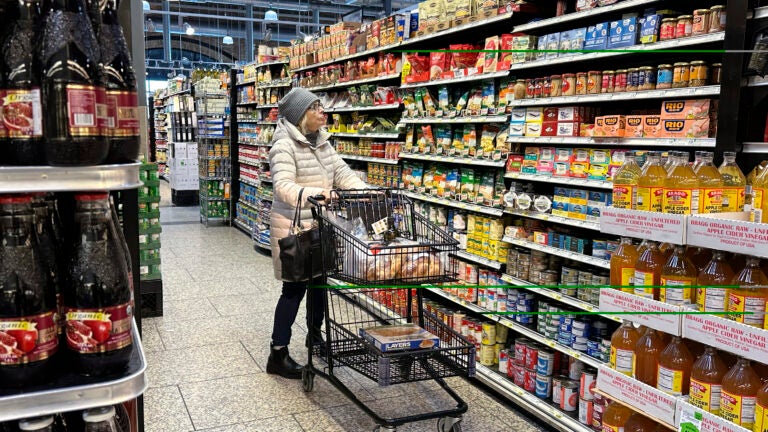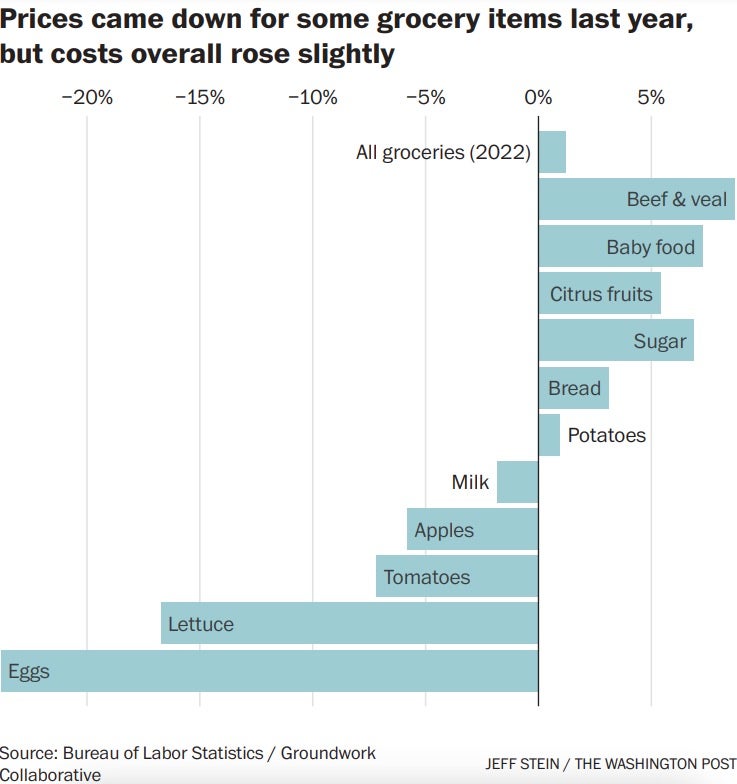National News
Price hikes have moderated throughout the U.S. economy but food prices have remained persistently high.

Nam Y. Huh / AP, File
Americans are finally getting a break from inflation, with prices for gasoline, used cars and health insurance all falling over the past year, relieving families and buoying President Biden’s 2024 reelection bid. But prices painfully remain high for one particularly frequent purchase: groceries.
Grocery prices have jumped by 25 percent over the past four years, outpacing overall inflation of 19 percent during the same period. And while prices of appliances, smartphones and a smattering of other goods have declined, groceries got slightly more expensive last year, with particularly sharp jumps for beef, sugar and juice, among other items.
Stubbornly high grocery prices represent a critical drain on the finances of tens of millions of people and remain, along with housing, perhaps the most persistent economic challenge for the Biden administration as it tries to convince Americans the economy is back on solid footing. For all the attention on gas prices and housing, more than two-thirds of voters say inflation has hit them hardest through higher food prices, according to a November 2023 survey by Yahoo Finance/Ipsos. That’s more than 50 percentage points higher than any other category.
But there is no immediate fix for policymakers. Grocery prices remain elevated due to a mixture of labor shortages tied to the pandemic, ongoing supply chain disruptions, droughts, avian flu and other factors far beyond the administration’s control. Robust consumer demand has also fueled a shift to more expensive groceries, and consolidation in the industry gives large chains the ability to keep prices high, economic policy experts say.
“I think people are waiting for prices to return to what they call ‘normal’ – and with the exception of a few things, like eggs – we’re not going to see that. We’re going to see prices stabilize, and that’s likely it,” said Dawn Thilmany, an agricultural economist and professor at Colorado State University.
The Groundwork Collaborative, a left-leaning think tank, reported Friday that almost 30 percent of the rise in grocery prices has been driven by just five categories of food particularly vulnerable to supply chain shocks, including beef, chicken, fruits and vegetables and snacks.
Not all the news is bad. The rate of growth for grocery prices substantially cooled last year, falling to 1.3 percent from 11.8 percent the year before.
And while grocery prices overall are up, some food items saw substantial declines. Egg prices, after soaring, fell by more than 20 percent last year. Lettuce prices fell 17 percent, andtomato prices fell by more than 7 percent, among similar other drops.
That momentum is expected to continue: The Agriculture Department expects grocery prices to drop 0.4 percent this year.
“It wasn’t until last year – three years into the pandemic – that we made big strides on ending the labor shortages. So it’s going to take some time,” said Claudia Sahm, an economist who worked at the Federal Reserve. “Disinflation is not going to happen in all parts of the economy equally at the same time.”

Pointing to a decline in the costs being paid by producers, the Biden administration has said grocery stores can do more to alleviate the sticker shock facing shoppers. An administration spokesman also cited actions it has taken so far to ease fertilizer prices, improve the capacity of the meat and poultry industries, and advance an antitrust agenda to increase competition in the agriculture sector. The Groundwork Collaborative report urged the Biden administration to go further, including by finalizing new rules to reduce concentration in the meatpacking industry.
“President Biden has made clear that as input prices fall, corporations should pass those savings on to consumers,” White House spokesman Michael Kikukawa said in a statement. “The Administration is cracking down on exploitative and anti-competitive behavior in meat and poultry markets, supporting state law enforcement efforts to stop practices that raise food prices, and pursuing all available avenues to lower grocery prices for families.”
The high grocery prices reflect a number of economic factors. The run-up in food costs began early in the pandemic, when supply-chain snarls and worker shortages collided with rampant demand for groceries. But more recent developments continue to keep prices high: Droughts and extreme heat have dampened production of fruits and vegetables. Dry spells in India and Thailand have curtailed sugar exports. And an ongoing avian flu outbreak, the largest in U.S. history, sent chicken and egg prices soaring, though egg prices fell after an initial spike.
Higher wages at processing plants, warehouses and grocery stores have also added to costs. Meanwhile, Russia’s invasion of Ukraine in early 2022 prompted a spike in commodity prices for wheat, corn and vegetable oils that are finally settling back down.
At the same time, demand for food – particularly meat, nuts and fresh produce – has remained elevated, as Americans splurge on higher-quality specialty goods and organic items, according to Thilmany, of Colorado State University. Households are generally allocating more to groceries than they were before the pandemic, even after accounting for inflation, in part because their buying habits have changed, she said.
“People started spending a ton on groceries during covid and for a large subset of Americans, that’s stuck,” Thilmany said. “They’re saying, ‘I’m still going to get that rib-eye or New York strip even if it costs more’ – and that pushes prices further up.”
The White House Council of Economic Advisers also found in a new report that grocery store profit margins remain higher than their pre-pandemic levels.
In Phoenix, Quentin Vaterlaus and his family are spending 70 percent more on groceries than they did before the pandemic. Their weekly supermarket hauls added up to more than $6,000 last year, up from about $3,500 in 2019, in part because they’re eating better, with more fresh herbs, whole wheat pastas and Kalamata olives.
Still, he says they’re shopping around more, toggling between Fry’s Food, Safeway and local farmers markets for the best deals.
“Higher prices have caused us to shop around a lot more or simply go without,” said Vaterlaus, 37, a data analyst whose household income has risen 40 percent since 2019. “We look at the weekly deals and only get what is on sale or needed.”
Grocery prices tend to play an outsize role in peoples’ perceptions of inflation. Unlike more infrequent expenses – car insurance, say, or property taxes – that might deliver a similar dose of sticker shock, the sheer frequency of grocery trips makes price increases harder to swallow, said Ross Steinman, a psychology professor at Widener University who studies consumer behavior. “When you’re buying a carton of eggs or a gallon of milk every week, it’s staring you right in the face over and over,” he said.
Low-income families have been hit hardest by rising grocery prices, and they spend 31 percent of their income on food, compared with 8 percent for wealthier ones. Food insecurity is rising and food banks around the country report significant increases in demand in the past year, particularly after the expiration of extra pandemic food stamps last February. (Still, the Biden administration has also approved the largest-ever expansion in the food stamps program, resulting in an extra $36 per recipient per month at the time.)
The Rhode Island Community Food Bank in Providence now serves about 80,000 people a month, up 20 percent from a year ago, according to Andrew Schiff, the food bank’s chief executive.
“This is absolutely the effect of high food prices,” he said. “The high cost of groceries, combined with much higher rents and utility bills, has been a big burden for low-income families. We do believe that if food goes down, that will be a very big help. That’s what we’re hoping for – that in the next year, food prices will decline.”
Jasmine Sanders works two jobs, at H&R Block and at a home health-care company, but still struggles to afford food for herself and her two young children in Helena, Mont.
The single mother receives about $200 a month in food stamps, enough to buy two weeks’ worth of groceries, she said. Sanders and her son are lactose intolerant, requiring her to buy pricier items like oat milk and dairy-free yogurt. But she’s cutting back where she can, buying more generic items and less fresh produce, and has started stopping by a local food pantry once a month.
The difficulty of putting food on the table is making Sanders, 23, rethink her political leanings. Until a few weeks ago, she wasn’t planning to vote in this year’s presidential election because both candidates seemed the same, “sitting at those fancy desks, making decisions for rich people.” But lately, people at work have started talking politics and she’s started to change her mind. Sanders feels her financial footing slipping away, and says she worries about the future.
“At the moment, Trump is looking like the better guy,” she said. “Last time, I thought he had too many scandals. But now with inflation going on, with prices the way they are, it seems like he wants to make the economy better for people like us.”
And yet Donald Trump’s policiesare poised to make grocery prices higher, not lower. The former president is campaigning on placing new tariffs on trillions of dollars of imports and mass deportations of undocumented immigrants, which would likely make costs significantly higher for domestic beef, chicken and dairy products. But for now at least, the politics of high grocery prices appears much more likely to be a problem for Biden.
“People are really confused why food prices are going up and down – what really stands out to people is the erraticism,” said Celinda Lake, a Democratic pollster. “Every day, people are saying: I used to leave the grocery store with three bags. And now it’s two for the same amount of money.”
Newsletter Signup
Stay up to date on all the latest news from Boston.com
>>> Read full article>>>
Copyright for syndicated content belongs to the linked Source : The Boston Globe – https://www.boston.com/uncategorized/national-news/2024/02/02/inflation-has-fallen-why-are-groceries-still-so-expensive/





























